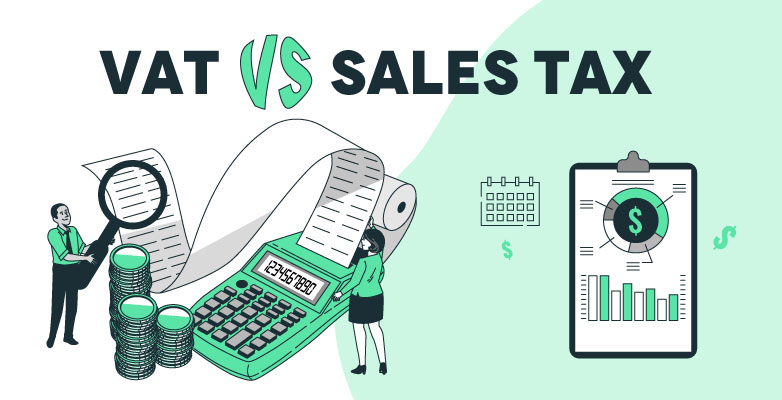In recent decades, the value-added tax (VAT) has emerged as the fastest-growing form of indirect taxation globally. Most countries, except the United States, heavily rely on VAT as a major source of government revenue. As the world becomes more interconnected through globalization, multinational corporations are increasingly seeking guidance on VAT and other indirect taxes, as these can constitute a significant portion of their overall tax obligations. Interestingly, the United States stands as the sole member of the Organisation for Economic Cooperation and Development (OECD) that does not implement a national-level VAT. Nonetheless, VAT has gained recognition as an important consideration in federal tax reform discussions.
VAT remains relatively unfamiliar to most U.S. taxpayers. At the state and local levels, only New Hampshire imposes a VAT-type tax known as the business enterprise tax. This tax is based on the enterprise value tax base, encompassing various elements like compensation, interest, and dividends paid or accrued by the business enterprise, subject to specific adjustments and apportionment rules. In this discussion, we will delve into the distinctions and common features between the VAT and retail sales tax systems. To establish a foundation for this comparison, we will first examine the typical structure of a VAT system.
Everyone is familiar with taxes, an inevitable part of our financial lives. As we navigate the complex world of taxation, it’s crucial to distinguish between various types of taxes and when they come into play.
Two taxes that are often conflated are Sales Tax and Value Added Tax (VAT). The principal distinction between these two lies in their timing of imposition:
Table of Content
- 1 Understanding Sales Tax
- 2 Understanding VAT (Value Added Tax)
- 3 6 Major Differences Between Sales Tax and VAT
- 4 Summing Up
- 5 Frequently Asked Questions
- 5.1 What is the fundamental difference between VAT and Sales Tax?
- 5.2 How does the taxable base vary between VAT and Sales Tax?
- 5.3 Who bears the tax burden in Sales Tax and VAT systems?
- 5.4 Is there a cascading effect in VAT and Sales Tax?
- 5.5 Why is Sales Tax sometimes referred to as a “Single-Point Tax”?
- 5.6 What is the reason behind VAT being termed a “Multi-Point Tax”?
Understanding Sales Tax
In the United States, sales tax is a type of fee calculated as a percentage of the price of goods and services and is imposed at the time of purchase. It falls under the category of consumption tax, specifically a general sales tax that is added to the cost of goods or services. Importantly, this tax is typically shouldered by the end-user or consumer of the product.
Sales taxes come into play whenever a business, be it a small local shop or a distribution center for a major corporation, has what’s known as a “sales tax nexus” in a specific jurisdiction. This nexus is established through a physical presence or a substantial volume of sales within that jurisdiction. It’s crucial to note that sales tax is not a federal-level tax; it is administered by state and local authorities.
Most items purchased by consumers at retail establishments, such as clothing and accessories, are subject to sales tax, although the specific rules and rates can vary between states. Some states may exempt certain items, like prescription medications and groceries intended for home use, from sales tax. Each state has the authority to set its own regulations regarding the collection and remittance of sales tax to the appropriate tax authority. Outside of the United States, other countries often employ excise taxes or a value-added tax (VAT) instead of the traditional sales tax system.
Key Characteristics of Sales Tax
- Sales tax is a nationwide tax applicable to final goods and services, those that have completed the production stages. Regardless of how many value additions occur during production, sales tax is only imposed when the product is fully manufactured.
- This tax is unique in that it’s a one-time charge, specifically when the product reaches the ultimate consumer. Consequently, it’s often referred to as a single-point or single-stage tax. Its calculation is straightforward due to its single imposition.
- Sales tax typically doesn’t lead to a cascading effect because it’s levied only once.
- The responsibility for paying this tax falls on the customer when they purchase the product. Interestingly, under certain circumstances, it’s possible to evade this tax.
How Does Sales Tax Function in the United States?
In the United States, the dynamics of sales tax liability vary from state to state, as do the categories of goods that are included or exempt from sales tax. Broadly, the onus of imposing the tax on consumers falls on the seller, and the revenue collected is subsequently remitted to state or local tax authorities. Here are several examples illustrating the diverse approaches taken by different states regarding sales tax:
- Vendor or Seller Privilege Tax States: In states operating under the vendor or seller privilege tax model, businesses are taxed for the privilege of conducting operations within a particular state. These businesses have the option to either absorb the sales tax themselves or pass it on to the consumer. States such as Michigan, Missouri, and South Carolina permit businesses to absorb the sales tax. However, in privileged tax states like Connecticut and Kentucky, sellers are legally required to levy the tax at the point of sale.
- Consumer Tax States: In states following the consumer sales tax model, the tax is applied directly to the consumer during a retail sale. Here, it is the customer’s responsibility to cover consumer retail sales taxes, with sellers collecting the tax on behalf of state authorities. In most consumer tax states like Vermont, West Virginia, and Oklahoma, sellers are prohibited from absorbing the tax.
- Transaction Tax States: Transaction tax states, including Colorado, Florida, Georgia, and Illinois, assign responsibility for paying the sales tax to both the buyer and the seller. However, there are variations in how this responsibility is structured; for example, in Colorado, it is illegal for the seller to absorb the tax, whereas in Georgia, it is permitted.
- Gross Receipts Tax (GRT) States: States that do not impose income tax, such as Washington and Delaware, utilize a GRT system. This entails a state tax on a business’s gross sales rather than a sales tax. In these states, the specifics of sales tax liability differ from the conventional sales tax approach, and the GRT is calculated based on a business’s total sales.
Understanding VAT (Value Added Tax)
A value-added tax, commonly known as VAT, is a type of consumption tax imposed at various stages of the supply and retail chain, serving as a source of government revenue for a nation. VAT is levied incrementally, starting from the acquisition of raw materials, and continuing through the production process. At each stage, a specific value is added to the product, and a corresponding VAT is applied. This cumulative value, which includes all the previous VAT amounts, is ultimately incorporated into the final retail price, and it’s the end consumer who bears the full burden of the VAT.
Throughout the supply chain, including wholesalers, producers, and retailers, each entity includes its applicable percentage of VAT to the sale, intending to recover the VAT paid at the previous step. Some items, such as children’s clothing and groceries, may qualify for reduced rates or exemptions from VAT.
In contrast to the United States, where sales tax rates vary by state, the rate of VAT is determined at the national level in each country. VAT operates as a uniform flat tax, unlike the progressive income tax system that imposes higher tax rates on individuals with greater incomes. Critics argue that VAT places a relatively higher tax burden on individuals with lower incomes, as they tend to spend a larger proportion of their earnings on taxable goods. However, it’s important to note that VAT enhances tax transparency at every stage of the supply chain, acting as a deterrent to tax evasion.
Key Characteristics of VAT
- VAT stands for Value Added Tax and operates by taxing products at every step of the supply chain, specifically when there’s an increase in the product’s value as it progresses through various production phases.
- This tax is consistently applied multiple times, giving rise to its classification as a multi-point or state tax. Its calculation can be complex due to its multiple levies.
- VAT often results in a cascading effect as it’s imposed multiple times during production and distribution.
- The tax burden of VAT is distributed across multiple parties in the supply chain, including manufacturers, wholesalers, retailers, and ultimately, the customers.
- Unlike sales tax, evasion of VAT is virtually impossible under any circumstance.
How Does VAT Work?
A value-added tax, commonly known as VAT, is a type of consumption tax imposed at various stages of the supply and retail chain, serving as a source of government revenue for a nation. VAT is levied incrementally, starting from the acquisition of raw materials and continuing through the production process. At each stage, a specific value is added to the product, and a corresponding VAT is applied. This cumulative value, which includes all the previous VAT amounts, is ultimately incorporated into the final retail price, and it’s the end consumer who bears the full burden of the VAT.
Throughout the supply chain, including wholesalers, producers, and retailers, each entity includes its applicable percentage of VAT to the sale, intending to recover the VAT paid at the previous step. Some items, such as children’s clothing and groceries, may qualify for reduced rates or exemptions from VAT.
In contrast to the United States, where sales tax rates vary by state, the rate of VAT is determined at the national level in each country. VAT operates as a uniform flat tax, unlike the progressive income tax system that imposes higher tax rates on individuals with greater incomes. Critics argue that VAT places a relatively higher tax burden on individuals with lower incomes, as they tend to spend a larger proportion of their earnings on taxable goods. However, it’s important to note that VAT enhances tax transparency at every stage of the supply chain, acting as a deterrent to tax evasion.
6 Major Differences Between Sales Tax and VAT
| Aspect | Sales Tax | VAT (Value Added Tax) |
|---|---|---|
| Definition | A tax is levied at each stage of the supply chain as value is added. | A tax levied at each stage of the supply chain as value is added. |
| Taxable Base | Charged on the total value of final goods and services. | Imposed on the value added during production and supply chain stages. |
| Payment | Payable only once, at the final stage. | Incurs multiple payments as value is added. |
| Nature | Single-Point or Single-Stage Tax. | Multi-Point or State Tax. |
| Tax Burden | Borne by the final customer. Others in the supply chain are not responsible. | Spread across all participants in the supply chain, including manufacturers, wholesalers, retailers, and consumers. |
| Cascading Effect | Typically lacks a cascading effect. | Features a cascading effect due to multiple levies. |
Summing Up
Sales tax and Value Added Tax (VAT) are concepts that can sometimes be perplexing, and people often use them interchangeably. However, it’s important to note a significant distinction: Sales tax is a one-time charge incurred only by the final customer when they purchase goods and services.
On the other hand, VAT operates differently. It applies multiple times during a product’s journey through various stages of the supply chain or whenever there is an increase in its value. If you still have questions or need further clarification, don’t hesitate to reach out to our experts for assistance.
Frequently Asked Questions
What is the fundamental difference between VAT and Sales Tax?
VAT and Sales Tax differ primarily in their point of application. While Sales Tax is charged only once at the final sale to consumers, VAT is levied multiple times as a product moves through various stages of the supply chain.
How does the taxable base vary between VAT and Sales Tax?
Sales Tax is calculated on the total value or amount of the final goods and services, as it is applied exclusively at that stage. In contrast, VAT is imposed on the value added during the product’s journey through the supply chain and production processes.
Who bears the tax burden in Sales Tax and VAT systems?
In the case of Sales Tax, the tax burden falls solely on the final customer who purchases the goods or services. Conversely, VAT is considered rationalized as it spreads the tax burden across all participants in the supply chain, including manufacturers, wholesalers, retailers, and consumers.
Is there a cascading effect in VAT and Sales Tax?
Sales Tax typically lacks a cascading effect since it is assessed only once at the final sale. In contrast, VAT exhibits a cascading effect because it is levied multiple times during the production and distribution processes.
Why is Sales Tax sometimes referred to as a “Single-Point Tax”?
Sales Tax is often called a “Single-Point Tax” because it is applied only once, specifically at the point of final sale to the consumer.
What is the reason behind VAT being termed a “Multi-Point Tax”?
VAT earns its label as a “Multi-Point Tax” due to its characteristic of being charged multiple times during a product’s journey through various supply chain stages and each instance of value addition.




